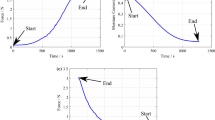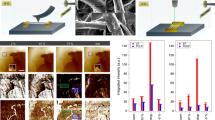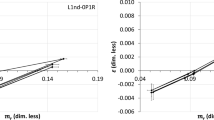Abstract
Measurements have been performed to clarify the connection between fibre–fibre joint properties and dimensional stability using laboratory sheets prepared from never-dried fibres, from heavily hornified fibres having a low molecular contact area between the fibres, and from both hornified and never-dried fibres treated with a polyelectrolyte multilayer (PEM) technique to increase the molecular contact area in the fibre–fibre joint. The influence of the drying mode, i.e. whether the sheets are dried freely or under restraint, was also evaluated. The results showed that neither paper strength nor fibre–fibre joint contact area had any significant influence on the dimensional stability of sheets dried under restraint. On the other hand, when the sheets were dried freely, the PEM-treated sheets expanded to the same extent as, or to an even greater extent than the non-PEM-treated sheets, even though they adsorbed less water for a given change in relative humidity. There was also a correlation between drying shrinkage and dimensional stability, where greater shrinkage was associated with a greater hygroexpansion in the freely dried sheets.












Similar content being viewed by others
References
Brecht W, Hildebrand W (1960) Über die Flächenbeständigkeit der Papiere. Das Papier 14(10A):610–624
Caulfield DF, Steffes RA (1969) Water-induced recrystallization of cellulose. Tappi 52:1361–1366
Eklund D (1969) Dimensional stability of paper from different types of pulp. Paperi Puu 51(2):153–155, 158–161
Eriksson M, Notley SM, Wågberg L (2005) The influence on paper strength properties when building multilayers of weak polyelectrolytes onto wood fibres. J Colloid Interface Sci 292(1):38–45
Eriksson M, Torgnysdotter A, Wågberg L (2006) Surface modification of wood fibers using the polyelectrolyte multilayer technique: effects on fiber joint and paper strength properties. Ind Eng Chem Res 45:5279–5286
Gallay W (1973) Stability of dimensions and form of paper. Tappi 56(2):54–63
Grignon J, Scallan AM (1980) Effect of pH and neutral salts upon the swelling of cellulose gels. J Appl Polym Sci 25:2829–2843
Jarrell TD (1927) Effect of atmospheric humidity on the moisture content of paper. Paper Trade J 85:47–51
Kajanto I, Niskanen K (1998) Dimensional stability. In: Niskanen K (ed) Paper physics. Fapet Oy, pp 222–259
Kato KL, Cameron RE (1999) A review of the relationship between thermally-accelerated ageing of paper and hornification. Cellulose 6:23–40
Laine J, Lindström T, Bremberg C, Glad-Nordmark G (2003) Studies on topochemical modification of cellulosic fibers part 5. Comparison of the effects of surface and bulk chemical modification and beating of pulp on paper properties. Nordic Pulp Paper Res J 18:325–332
Lavrykov SA, Ramarao BV, Lyne ÅL (2004) The planar transient hygroexpansion of copy paper: experiments and analysis. Nordic Pulp Paper Res J 19:183–190
Leisen J, Hojjatie B, Coffin DW, Lavrykov SA, Ramarao BV, Beckham HW (2002) Through-plane diffusion of moisture in paper detected by magnetic resonance imaging. Ind Eng Chem Res 41:6555–6565
Lindström T, Carlsson G (1978) The effect of chemical environment on fiber swelling. In: Pap. – Eucepa symp, pp 32–52
Lundberg R, de Ruvo A (1978) The influence of drying conditions on the recovery of swelling and strength of recycled fibers. Sven Papperstidn 81:355–358
Lyne ÅL, Fellers C, Kolseth P (1994) Three dimensional hygroexpansivity of unfilled and filled laboratory made fine papers. Appita J 47:380–386, 401
Nanri Y, Uesaka T (1993) Dimensional stability of mechanical pulps – drying shrinkage and hygroexpansivity. Tappi J 76(6):62–66
Neagu RC, Gamstedt EK, Lindström M (2005) Influence of wood-fibre hygroexpansion on the dimensional instability of fibre mats and composites. Composites Part A: Appl Sci Manuf 36A:772–788
Niskanen KJ, Kuskowski SJ, Bronkhorst CA (1997) Dynamic hygroexpansion of paperboards. Nordic Pulp Paper Res J 12:103–110
Nordman L (1958) Laboratory investigations into the dimensional stability of paper. Tappi 41:23–30
Page DH, Tydeman PA (1962) A new theory of the shrinkage, structure and properties of paper. In: Formation and structure of paper. 2nd fundamental research symposium, pp 397–413
Pekarovicova A, Venditti RA, Cao H, Lou YM, Jean YC (1997) Cellulose free volume characterization using positron annihilation lifetime spectroscopy. J Pulp Pap Sci 23:J101–J107
Salmén L, Boman R, Fellers C, Htun M (1987) The implications of fiber and sheet structure for the hygroexpansivity of paper. Nordic Pulp Paper Res J 2:127–131
Schultz-Eklund O, Fellers C, Johansson PÅ (1992) Method for the local determination of the thickness and density of paper. Nordic Pulp Paper Res J 7:133–139, 154
Stone JE, Scallan AM (1967) Effect of component removal upon the porous structure of the cellwalls of wood. II. Swelling in water and the fier saturation point. Tappi 50(10):496–501
Torgnysdotter A, Wågberg L (2006) Tailoring of fibre/fibre joints in order to avoid the negative impacts of drying on paper properties. Nordic Pulp Paper Res J 21:411–418
Tydeman PA, Wembridge DR, Page DH (1966) Transverse shrinkage of individual fibers by microradiography. In: Consol. pap. web. trans. symp., pp 119–144
Uesaka T (1991) Dimensional stability of paper. Upgrading paper performance in end use. J Pulp Pap Sci 17:J39–J46
Uesaka T (2002) Dimensional stability and environmental effects on paper properties. In: Mark RE (ed) Handbook of physical testing of paper. Marcel Dekker, Inc., New York, pp 115–171
Uesaka T, Qi D (1994) Hygroexpansivity of paper – effects of fiber-to-fiber bonding. J Pulp Pap Sci 20:175–179
Uesaka T, Kodaka I, Okushima S, Fukuchi R (1989) History-dependent dimensional stability of paper. Rheol Acta 28:238–245
Uesaka T, Moss C, Nanri Y (1992) The characterization of hygroexpansivity of paper. J Pulp Pap Sci 18:11–16
Wågberg L, Hägglund R (2001) Kinetics of polyelectrolyte adsorption on cellulosic fibers. Langmuir 17:1096–1103
Wågberg L, Forsberg S, Johansson A, Juntti P (2002) Engineering of fibre surface properties by application of the polyelectrolyte multilayer concept. Part I. Modification of paper strength. J Pulp Pap Sci 28:222–228
Acknowledgments
BIM Kemi Sweden AB and the Knowledge Foundation through its graduate school YPK are acknowledged for financial support. STFI-Packforsk is acknowledged for granting access to their facilities and Sune Karlsson, STFI-Packforsk, and Jarmo Tulonen, TJT-Teknik AB, are thanked for helping with the dimensional stability equipment. Jarmo Tulonen is also acknowledged for substantially contributing to the design of the drying-frame. Mats Rundlöf, AB Capisco, is acknowledged for the aid with the fibre–fibre joint illustration.
Author information
Authors and Affiliations
Corresponding author
Rights and permissions
About this article
Cite this article
Larsson, P.A., Wågberg, L. Influence of fibre–fibre joint properties on the dimensional stability of paper. Cellulose 15, 515–525 (2008). https://doi.org/10.1007/s10570-008-9203-y
Received:
Accepted:
Published:
Issue Date:
DOI: https://doi.org/10.1007/s10570-008-9203-y




